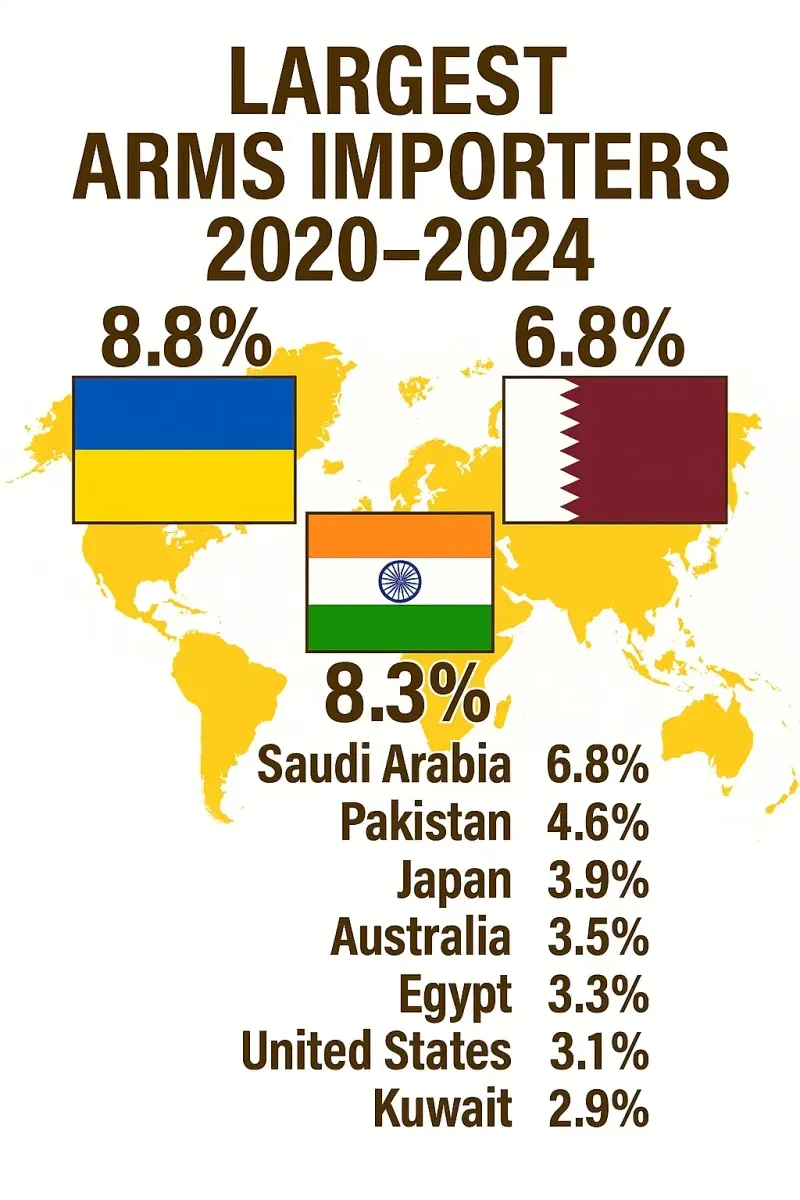Published
in Economy
According to SIPRI data, Ukraine became the world's top arms importer between 2020 and 2024, accounting for 8.8% of global imports. This sharp increase is driven by ongoing conflict and heightened security concerns across Europe and Asia.
Ukraine's arms imports skyrocketed by nearly 100 times compared to the previous five-year period, making it the largest arms importer globally with 8.8% of the world total. The surge is due to extensive military aid and purchases in response to Russia’s invasion in 2022. The country received a wide range of advanced weapon systems, including artillery, air defense, drones, and armored vehicles, primarily from the United States, Germany, and Poland.
India, traditionally among the top importers, ranked second with 8.3%, focusing on modernizing its military through purchases from Russia, France, and Israel. Qatar and Saudi Arabia each accounted for 6.8% of global imports, driven by regional tensions and long-term modernization efforts. Pakistan followed with 4.6%, continuing its procurement from China and other partners to balance regional power.
Several Asian and Middle Eastern countries dominate the top of the list, reflecting regional arms races and shifting alliances. Japan (3.9%), Australia (3.5%), and Kuwait (2.9%) all boosted imports for air defense, naval, and surveillance systems. Many of these acquisitions are designed to counter threats from China, Iran, or North Korea, or to deepen military interoperability with Western allies.
Europe increased arms imports by 94% between 2019–2023 compared to the previous five years, according to SIPRI. Apart from Ukraine, several NATO countries also sharply increased their purchases from the U.S. and European suppliers, aiming to strengthen defenses and reduce dependence on Russian arms after 2022.
A significant portion of the global arms import market is made up of countries each accounting for less than 1%. Collectively, these include Egypt (3.3%), South Korea, Indonesia, and several NATO members in Eastern Europe. These countries often focus on specific technologies such as missile defense, drones, or training aircraft. Some, like South Korea and Israel, are also becoming exporters while still importing niche technologies.
The imported arms include fighter jets, main battle tanks, missile systems, surveillance drones, and command-and-control technologies. They are used for national defense, deterrence, modernization of aging fleets, and, increasingly, for domestic conflict prevention and peacekeeping deployments abroad.

Ukraine was the largest arms importer during this period, accounting for 8.8% of global imports, driven by military needs following the Russian invasion in 2022.
India continued modernizing its armed forces, sourcing weapons from a variety of suppliers including Russia, France, and the U.S., to counter regional threats and diversify its defense portfolio.
The most common imports include fighter aircraft, missile systems, drones, tanks, air defense systems, and electronic warfare equipment.
While each contributes less than 1% individually, collectively these countries represent a substantial share of the market and often pursue targeted military upgrades or niche technologies.
It has significantly shifted global arms flows toward Europe and Ukraine, reduced Russia’s ability to export, and increased demand for NATO-standard equipment.